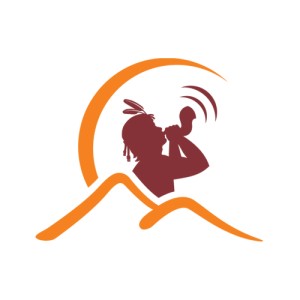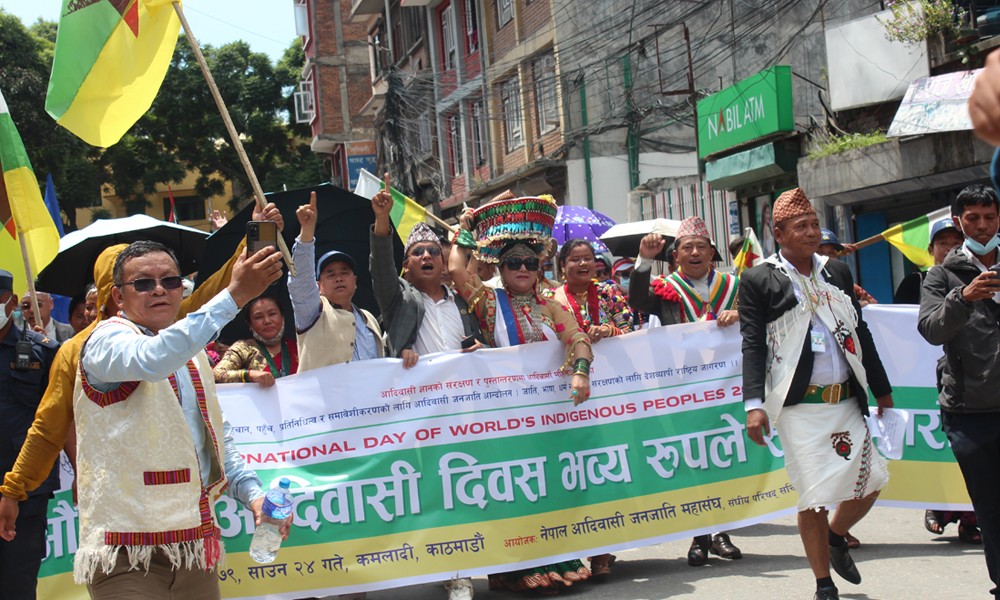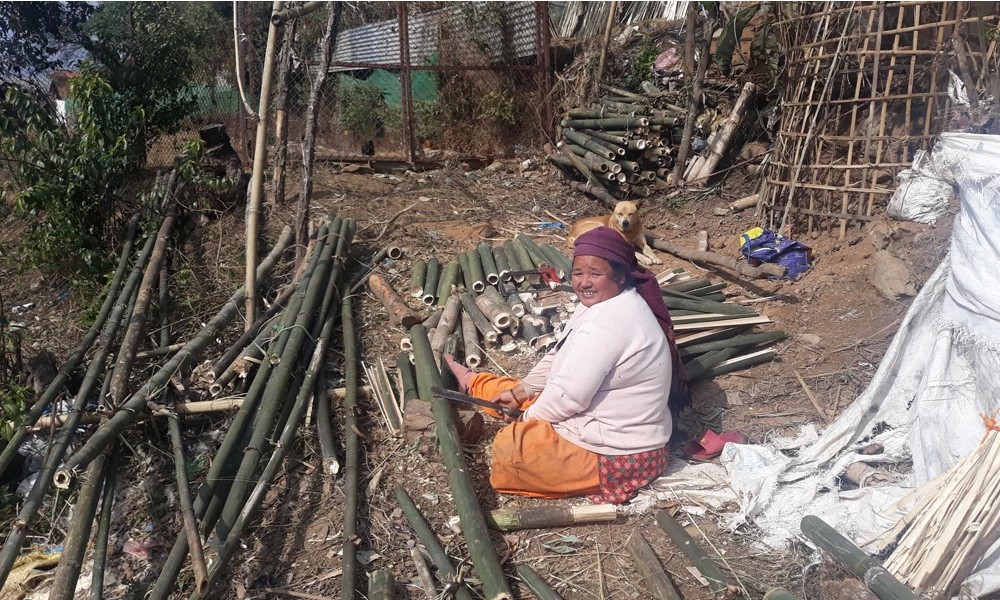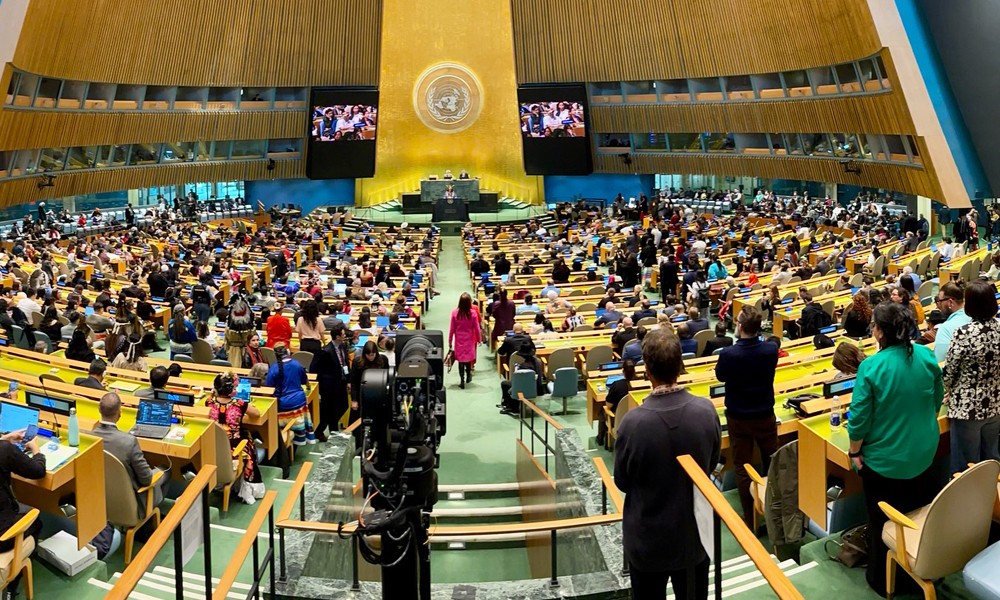International Day of World's Indigenous Peoples- 2022
O.B. Chamling Rai
Bam Kumari Budha Magar loves to wear her ethnic attire on most occasions, especially when she is attending a public event. For the 81-year-old indigenous rights activist, wearing traditional Magar dress is less about her public appearance -- it is more about her cultural identity.
As Bam Kumari recently sat against the wall of her house to record a video message for the International Day of the World's Indigenous Peoples (August 9), she made it a point to sport her beautifully woven Magar attire and ornament.
WATCH, Bam Kumari Budha:
Bam Kumari learned to handweave traditional hemp shawls while growing up in her remote village of Rolpa district. Like most indigenous women, she too learned this craft from her own mother.
"For me, my mother was a university in herself," says Bam Kumari, Rolpa's first woman to pass the SLC -- the erstwhile version of the SEE exams. "We all learn our indigenous knowledge from our mothers."
The skills to handweave traditional attire forms part of a vast repertoire of indigenous knowledge, which continues to be neglected in Nepal due to various factors. A key factor in neglecting such indigenous knowledge is a lack of political commitment and policy. Instead of preserving and promoting rich indigenous knowledge, the government has always pushed it toward the brink of extinction.
"For me, my mother was a university in herself," says Bam Kumari, Rolpa's first woman to pass the SLC -- the erstwhile version of the SEE exams. "We all learn our indigenous knowledge from our mothers."
For example, hemp is a great fabric to handweave traditional clothes. In mid-western hills of Rolpa and Rukum, indigenous women like Bam Kumari have long been growing hemp to get fabric for their traditional clothes. But when the government banned cannabis in 1976, it became increasingly more difficult to grow hemp even for weaving traditional clothes.
Bam Kumari says: "The local administration now allows a family to grow only up to 25 hemp plants. But that is not enough (for us to make hemp clothes)."
She adds: "By not allowing the plantation of hemp, the government has prevented us from applying our indigenous knowledge."
Nepal spends millions of US dollars to import clothes from abroad, which is causing the country's trade deficit -- mainly with India -- to balloon every year. There is a chance for the government to significantly reduce its trade deficit by minimizing the import of clothes, and one way to do it is to promote Nepal's own clothing brands, including indigenous communities' handwoven ethnic attire.
Nepal's indigenous communities were once totally self-reliant on clothes. They would spin yarn with their own hands, or on a wheel. They would dye yarn using locally available coloring materials. And then they would handweave various types of clothes: Bhangra, Ghalek, Bakkhu, etc.
After Nepal opened up to the world with the fall of the Rana oligarchy in 1950, the country started importing clothes from India, China and other countries. However, even amidst the growing trend of wearing imported clothes, indigenous communities were still weaving their clothes by using handlooms.
National Indigenous Women's Federation (NIWF)'s General Secretary Shanti Dewan says: "Women play the most important role in the preservation, promotion and transmission of indigenous knowledge."
The skills to build handlooms and use them to weave traditional clothes are an inherent part of indigenous knowledge. In eastern hills, indigenous Limbu women would use handlooms to weave different types of clothes for them, and for their family members. Handlooms were so essential to their lifestyle and the economy that they feature prominently in Mundhum, the orally transmitted religious scripture and literature of indigenous Limbu community.
In fact, it is women in every indigenous community who play a key role in the preservation and transmission of traditional knowledge. National Indigenous Women's Federation (NIWF)'s General Secretary Shanti Dewan says: "Women play the most important role in the preservation, promotion and transmission of indigenous knowledge."
She adds: "For example, indigenous Yakkha people -- which I belong to -- wear traditionally woven shawls or mufflers decorated with patterns of unyu (fern). Unyu is a symbol of good luck in our culture. These unyu-printed shawls and mufflers are woven by Yakkha women. They transfer this traditional knowledge and skill to their daughters and grand-daughters."
WATCH, Shanti Dewan:
Indigenous knowledge is not limited to handweaving traditional clothes. According to Paramparagat Aadivasi Gyan (Traditional Indigenous Knowledge), a book written by Kumar Yatru and published by Indigenous Media Foundation, indigenous knowledge can be found everywhere -- from biodiversity conservation to climate change adaptation or from healthcare to crisis management.
But this vast indigenous knowledge is facing existential threats. Yatru argues: "Globalization, modernization, urbanization as well as the State's anti-indigenous knowledge policies have endangered our native science.
Center for Indigenous People's Research and Development (CIPRED)'s Executive Director Dr Pasang Dolma Sherpa say: "Indigenous women can play a critical role in preserving indigenous knowledge. To further encourage women to preserve, promote and transmit indigenous knowledge, their role and contribution must get due recognition. Our customary institutions through which women apply our indigenous knowledge must also be recognized."
WATCH: Dr Pasang Dolma Sherpa,










